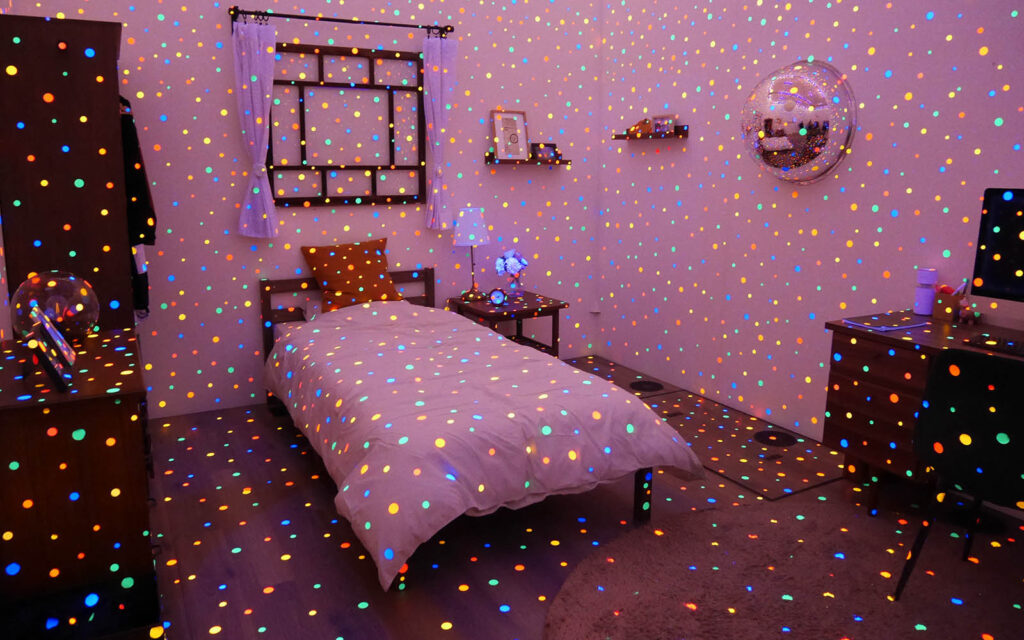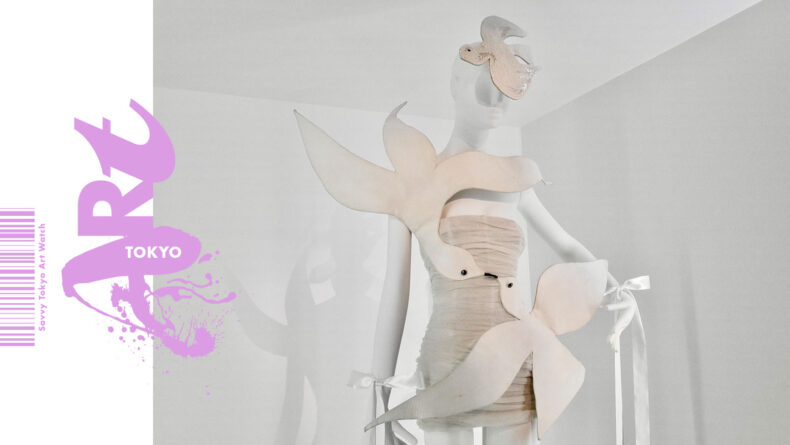Tokyo Art Scene: Capturing Emotion Through Color
Uncover hidden truths layered between paint strokes
Explore exhibitions in Tokyo featuring famous artists showcasing expressive paintings that leave a lasting impression.
In this month’s Tokyo Art Scene, the profound interplay of provocative emotion and vibrant hues combine into the thematic umbrella of Capturing Emotion Through Color. Throughout history, paintings have served as powerful tools, narrating stories and guiding viewers on unique journeys. In contemporary times, various forms and styles have emerged, shifting the focus of paintings. In this article, we will dive into the significance of color, exploring how it not only reflects the artist’s state of mind but also resonates deeply within our psyche.
Yayoi Kusama: Visionary Colors
 © Photo by Michele Tanabe
© Photo by Michele TanabeWhile many are acquainted with the distinctive polka dots and pumpkins synonymous with the contemporary artist Yayoi Kusama, her iconic designs have become even more ubiquitous in Tokyo, particularly with the highly coveted Louis Vuitton x Yayoi Kusama collaboration released earlier this year. Enthusiasts of the artist and admirers of paintings bursting with color will enjoy Yayoi Kusama’s latest exhibition, Visionary Colors. Housed in the ultramodern Shinjuku Yayoi Kusama Museum, this recently inaugurated exhibition showcases works spanning Kusama’s entire career, including pieces from her most recent series, Every Day I Pray For Love, crafted from 2021 to the present.
 © Photo by Michele Tanabe
© Photo by Michele TanabeAs visitors step into the museum, they are greeted by the three-dimensional piece Tower. This fluorescent pink polka-dotted structure reflects Kusama’s childhood hallucinations. In tandem, an adjoining painting, echoing the vibrancy and design, reveals a deeper layer upon closer examination, with the polka dots transforming into biological forms. The second and third floors display a variety of pieces ranging from earlier to recent years. On these levels, visitors can immerse themselves in Kusama’s iconic floral shapes, dots, infinity nets, twisting phalli and dark lines. The juxtaposition of dark textures overlaid with vibrant colors creates a visceral experience conveying the artist’s fluctuating emotional states.
 © Photo by Yayoi Kusama Museum
© Photo by Yayoi Kusama MuseumOn the fourth floor, visitors encounter an immersive, room-sized installation titled I’m Here, but Nothing, providing a glimpse into some of the performances Kusama staged during her time in New York in the 1960s. The interior of the installation resembles a simple living room adorned with bright fluorescent polka dots illuminated by black light. The room evokes a sense of drifting, allowing viewers to spend a few minutes undisturbed inside. Moving to the final fifth floor, one finds Flowers That in Bloom at Midnight, a vivid three-dimensional piece that echoes Kusama’s consistent exploration of sculpture and installations. Keep in mind that tickets are not available at the door, all tickets must be purchased in advance only through the museum’s website. Entry is timed and only valid for a specific 70 visitors per 90 minute time-slot.
- Date
- Now through Sun, Mar. 24, 2024
- Time
- From 11 A.M. to 5:30 P.M. Thursdays to Sundays and National Holidays (Closed on Mondays, Tuesdays and Wednesdays and New Year Holidays: Dec. 25, 2023 - Jan. 5, 2024)
- Location
- 107 Bentencho, Shinjuku City, Tokyo - Map
- Fee
- ¥1,100 (Adults), ¥600 (Children and young adults aged 6 to 18), Free (Children aged 6 and under)
- Info
- 7-minute walk from Waseda station, 6-minute walk from Ushigome Yanagicho station and 9-minute walk from Kagurazaka station
Mark Dean Veca: “Good Vibes”
 © Photo by Michele Tanabe
© Photo by Michele TanabeNestled within the financial district of Otemachi, an unlikely gallery filled with vibrant art and sophisticated decor draws in passersby. The newly opened Tokyo Diaspora Contemporary Art Gallery aims to showcase the works of international artists while fostering connections among art enthusiasts and emerging local talents. This gallery’s first exhibition, Good Vibes, by Los Angeles artist Mark Dean Veca, emanates positive emotions in an inviting atmosphere that sparks creativity.
 © Photo by Michele Tanabe
© Photo by Michele TanabeThe playful contrasting colors of the exhibition can be seen from a distance through the gallery’s glass windows. However, as visitors step inside, they are instantly greeted with splashes of pigment and familiar characters. Among the sculptures near the entrance, a blue and white-patterned Pinocchio smiles happily into the void, leaving room for interpretation by the viewer. Moving deeper into the exhibition, you may find yourself face to face with an emaciated Pillsbury Doughboy or your favorite potato chip mascot. This solo exhibition provides a rare glimpse of Veca’s provocative style, encompassing stylized pop art and psychedelic shades through twisting textures and patterns.
 © Photo by Michele Tanabe
© Photo by Michele TanabeThe intimate culture of this gallery affords most who visit the chance to chat with gallery director and fellow contemporary artist, Sush Machida. Those interested in uncovering the behind-the-scenes process of curating this exhibition will be enlightened by Mahida’s thoughtful guidance. Look out for current news and upcoming exhibitions at the gallery’s Instagram page.
- Date
- Now through Sat Dec. 23, 2023
- Time
- From 1 P.M. to 7 P.M. (Closed Mon, Tues and Wed)
- Location
- 1-12-6 Uchikanda, Chiyoda City, Tokyo - Map
- Fee
- Free
- Info
- 5-minute walk from Otemachi station, 6-minute walk from Kanda station
Anish Kapoor: Looking at the Deprived of Freedom —The Future of Surveillance Society
 © Photo by Michele Tanabe
© Photo by Michele TanabeFor those eager to fall into an artistic and thought-provoking respite amid the hustle and bustle of holiday shopping in the crowded streets of Harajuku and Omotesando, a visit to Anish Kapoor’s latest exhibition is a must. This thoughtful collection is truly exceptional as it serves as a commentary on the complex and often challenging emotions faced by individuals and society in the era of ubiquitous surveillance.
 © Photo by Michele Tanabe
© Photo by Michele TanabeIn an age dominated by social media and algorithm-driven advertising, an eerie, ever-watchful presence seems to weave itself into our daily lives. The Future of Surveillance Society contemplates those who willingly engage in this transactional behavior, revealing a darker undercurrent tightly bound to human emotion.
The exhibit unfolds across three distinct chapters: Chapter One, Birth of the Prison Without a Ceiling, Chapter Two: Big Brother and Chapter Three: The Monster of Totality. Each chapter guides you through a narrative woven from the sticky red piles of gore strewn across the gallery to the purposeful paintings and mixed media. The crimson red, gushing forth amid contrasting bright blues and purples serves as a visceral and deliberate visual storytelling device.
 © Photo by Michele Tanabe
© Photo by Michele TanabeIt’s recommended to pause at each chapter description to read before delving into the corresponding segment’s works. Kapoor’s deliberate choice of these specific colors serves to mirror the often chaotic and untethered emotions associated with the uncharted territory humanity, and our world as we know it, has ventured into.
- Date
- Now through Sun Jan. 28, 2024
- Time
- From 11 A.M. to 8 P.M. (Closed Dec. 31 to Jan. 1, 2024)
- Location
- Gyre 3F, 5 −10−1 Jingumae, Shibuya City, Tokyo - Map
- Fee
- Free
- Info
- 4-minute walk from Meiji-jingumae station, 5-minute walk from Omotesando station
Whether you immerse yourself in the vibrant colors of Yayoi Kusama’s new exhibition, Kapoor’s haunting works or venture into Otemachi for a more personal gallery experience, you’re sure to find something to spark emotion in this month’s Tokyo Art Scene.
















Leave a Reply